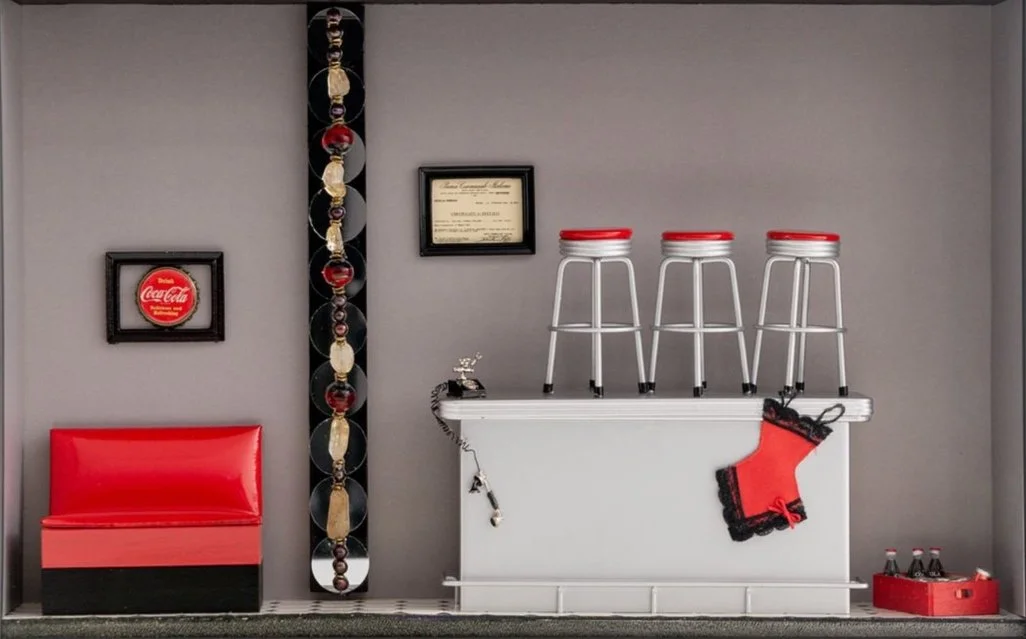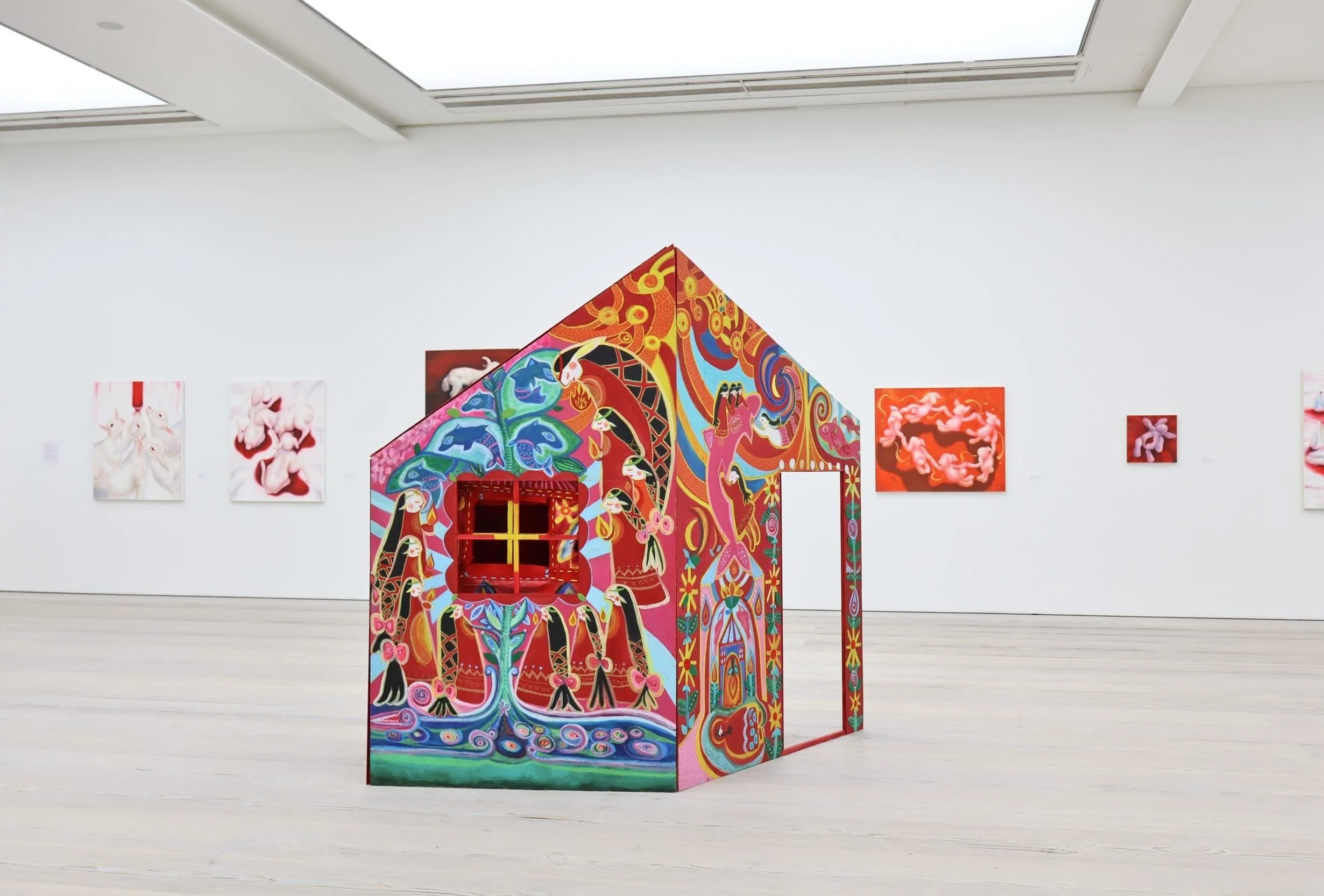10 Questions with Vivian Cavalieri
Vivian Cavalieri is a visual artist with a studio on Chincoteague Island, Virginia. Her three-dimensional miniature scenes prompt conversations on a range of global issues, including immigration and social justice. Her work has appeared in numerous group exhibitions in the US and abroad, including Los Angeles, Paris, Venice, and Rome. Her first solo exhibition is scheduled for January 2025. She was long-listed for the 2024 Visual Art Open and short-listed for the 2024 John Richardson French Residency Award. Recent publications include Suboart (December 2023), Art Seen (February 2024), Modern Renaissance Magazine (July 2024), and the Summer 2024 issues of Collect Art and Forget-Me-Not Press (Wretched). Cavalieri graduated from Harvard University (BA, Fine Arts) and the New York University School of Law. She is represented by Hambly & Hambly Gallery, Northern Ireland, UK.
Vivian Cavalieri - Portrait
ARTIST STATEMENT
Vivian Cavalieri is a conceptual artist creating three-dimensional mixed-media scenes that spark conversations on topics such as immigration, climate change, and social justice. Her assemblages incorporate a segment of a necklace she designed into scenes crafted with dollhouse miniatures, fabrics, and other commercially manufactured items. Though these items may seem impersonal, the items selected are symbolic, with deeply personal meanings. Rather than criticize or preach, she invites dialogue, fostering awareness and empathy by highlighting common challenges. She encourages viewers to engage with the small-scale scenes, framed with museum glass, which creates the illusion of being present at the scene. When converting assemblages into installations, she invites viewers not only to approach but to become fully immersed in the experience. Through this immersive experience, her intention is to cultivate a deeper understanding of the universal human experiences that connect us.
The Diner (Coming to America), mixed media, 12.5” x 18.75” x 4” © Vivian Cavalieri
INTERVIEW
First of all, introduce yourself to our readers. Who are you, and how did you become interested in art?
I grew up in Manhattan with an American-born mother and a Venetian father, speaking both English and Italian. Many childhood summers were spent in Venice at the beach, visiting churches and museums, and with relatives, especially with my father's cousin, the painter Laura Padoa. Looking back, I now realize how much those visits formed my sense of style and self.
European art and antiques-filled our New York apartment, and from the time I was three years old, each Saturday, my father would take me to visit a gallery or museum. Resistant at first, I came to appreciate these weekend mornings absorbing works of art and culture. Between my home life and my frequent visits to Venice, I was heavily influenced by art and chose to major in art history in college.
What inspired you to transition from studying art history to pursuing law, and how has this unique background influenced your approach to creating art?
At school, I was exposed to only two forms of art — painting and drawing. Thinking I had no artistic talent because I could not do either well, I studied art history as an avocation, and upon graduating from college, I drifted into law school. I then spent the next 20 years at law firms in New York and Washington, DC, representing nonprofits. As an attorney, I honed my writing skills, which now enable me to articulate key aspects of my creative process and my themes. Those years spent imposing order on chaos have their parallel in my current art process, creating a highly structured artwork from disparate, unrelated elements.
What Price Silence?, mixed media, 16” x 12” x 4" © Vivian Cavalieri
Your time spent in Venice, where your father was from, seems to be another great influence on your work. Can you tell us more about it?
Venice was and remains a powerful influence on my life and on my art. The city's magical, almost unreal beauty and its ornate, ebullient style was omnipresent — not only during my visits but every evening in New York as our flatware, glasses and lamps were Venetian. My frequent trips to Venice cemented my deep affection for that city, and a strong bond remains to this day.
I feel at home the moment I set foot there. My Venetian-born father is now buried beside his parents in the Cimitero Ebraico on the Lido (a UN World Heritage site), the paintings of my father's cousin Laura still hang in a popular restaurant near the Rialto (alla Madonna), and I look forward to every opportunity to spend time with my Venetian relatives.
After leaving the practice of law, I began designing multi-strand necklaces, unconsciously mirroring the opulent and joyful Venetian style. My multi-strand necklace designs are reminiscent of the torsades so prevalent in Venice when I was young. While those were composed of ten or more twisted strands of identical, small Murano glass beads, I incorporated other materials, including amber, abalone, semiprecious stones, and freshwater pearls. In memory of my father, each necklace included at least one bead of Murano glass. Ten years later, when large necklaces were no longer in style, and I found myself unsatisfied creating simpler single-strand necklaces, I transferred my process and approach to a different medium, using necklaces still in inventory in conceptual mixed media assemblages.
As with my necklace designs, my assemblages rarely rely on symmetry but achieve balance through careful juxtaposition of color, form, and texture. Here, too, Venetian style shines through. I consciously create an attractive scene so viewers will approach and hear what I have to say. Similarly, although inspired by a serious theme — say, concern over light pollution or climate change — I avoid preaching, preferring to make my point through gentle humor. In that way, I encourage even difficult conversations between the art and its viewers without imposing my viewpoint on them.
I dedicate substantial amounts of time selecting the precise color and shades used. To preserve the color intensity in my assemblages, I frame them with museum glass. Not surprisingly, my palette has been described as "Italianate".
Can you walk us through your creative process when working on a new assemblage? How do you decide on the materials and themes to incorporate?
I first select a necklace segment and consider what feeling its color and texture inspire. From this, I derive a theme and an initial design. I dedicate a lot of time to selecting the materials to add. In many instances, the items have a symbolic or deeper meaning, as with the miniature chairs in Second Chances and Transformations (from Bibendum to the Michelin Man). Those seeking details can find them on exhibition signage, in my newsletters, and/or on my website.
I rely heavily on high-quality dollhouse miniatures and lush textured fabrics because they pair well with the rich components in the necklace segments. When I want to include animals, I seek out realistic models, even for surrealistic scenes. My studio houses a large inventory of these and a wide range of mirrors, artboards, paints, and other craft items.
On the Rocks, mixed media, 8.5” x 12” x 4” © Vivian Cavalieri
Born Free, mixed media, 10” x 17” x 4” © Vivian Cavalieri
What themes or concepts do you often explore in your artwork, and are there any recurring motifs or symbols that hold personal significance for you?
As the daughter of an immigrant, I am keenly aware of the worldwide conversations regarding immigration. I owe my existence to the sanctuary my father found in the US during World War II, and I try to encourage compassion for those who desperately seek a better, safer existence.
Other facets of social justice appear frequently in my work as well. As a woman, I am aware of the struggle for recognition faced not only by women but by all those treated as second-class citizens or, worse, sub-human. My art encourages conversations on the commonalities we share, both the joys we experience and the challenges we face.
With an art studio on an island overlooking our oyster farm, I am keenly aware of the natural world and how humans affect it. Climate change, pollution, and human interactions with other species are never far from my mind.
Have any particular artists, movements, or historical periods significantly influenced your work?
The works of Joseph Cornell heavily influenced my decision to create small-scale assemblages within a contained space. Many of my miniature scenes are symbolic, and frequently an item chosen for a scene itself has a particular meaning. In this respect, my work follows in the ancient tradition of embedding hidden messages in art.
In what ways do you seek to engage with your audience through your art? Do you have specific messages or emotions you hope to convey through your creations?
Much conceptual art is so large or so powerful that a viewer is unable or unlikely to want to take it home. I design assemblages people will want to place on their walls where it remains a constant reminder of the topic it addresses.
War & Peace (Ivy & Orchids), mixed media, 18” x 22” x 4” © Vivian Cavalieri
Can you discuss a piece of your artwork that challenged you creatively or conceptually? How did you overcome any obstacles or doubts during the artistic process?
With respect to theme, when research reveals a topic is far more complex than I initially realized and that, therefore, my original design will not work, I either modify the way I approach the topic — selecting, for example, a different main character — or set aside the topic entirely until I can conceive a design that treats the subject fairly and accurately.
With respect to process, the shift from designing necklaces to creating miniature scenes required me to learn new skills, forced me to limit my designs to the custom frame, and required me to consider the laws of gravity. While I have been open to learning new skills such as woodworking and sewing, the restrictions imposed by the depth of the frame and the laws of gravity have often required adjustments to my original concept.
When I sense a design is not working, I set it aside for a few days. If I remain unable to decide why it is not working, I ask friends and family to articulate their thoughts on it.
Looking ahead, what are your aspirations and goals for your career as an artist? Are there any new directions or projects you're excited to explore in the future?
I plan to install a life-size version of my assemblage, "The Diner (Coming to America)." The assemblage contrasts the iconic 1950s American diner (symbolizing hope for a new beginning) with symbols of the reason for leaving and what had to be left behind. Disguised as a business license on the wall is the portion of my father's 1939 US visa application that states that he was fired because he was Jewish. The installation will reproduce the assemblage exactly but include a matching, wheelchair-accessible table and chairs where visitors will be encouraged to sit and describe their family's reasons for being willing to — or having to — start anew. I estimate the installation will be approximately 20 feet long, 8-10 feet high, and 10 feet deep. I envision the histories being written on a tablet and digitally recorded. Taken together, the narratives will highlight the personal tales behind immigration statistics.
And lastly, do you have any new projects or upcoming exhibitions you want to share with our public?
My first solo exhibition will take place in January 2025 on the website of Women United Art Movement.
Artist’s Talk
Al-Tiba9 Interviews is a promotional platform for artists to articulate their vision and engage them with our diverse readership through a published art dialogue. The artists are interviewed by Mohamed Benhadj, the founder & curator of Al-Tiba9, to highlight their artistic careers and introduce them to the international contemporary art scene across our vast network of museums, galleries, art professionals, art dealers, collectors, and art lovers across the globe.





















